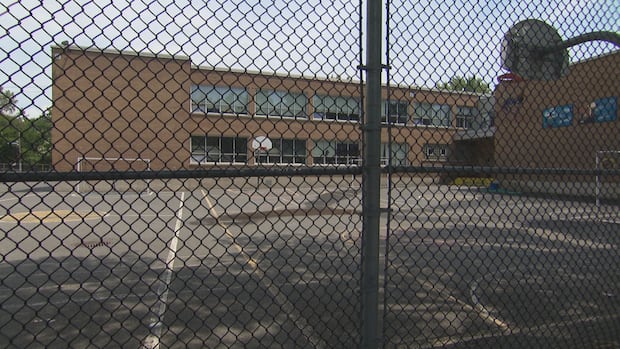[
The hot, muggy weather across much of Ontario and southwestern Quebec is dragging down the final days of school for Scarlett Rabideau.
“It’s really hot, and they don’t have any air conditioning inside, only at the library,” the Grade 2 student said in Toronto on Monday. “Most of the people in my class just go to the fans and sit.”
When it’s hot, “I like it, but I don’t like it,” chimed in Lily Ryan, a fellow second-grader. “Sometimes we have popsicles.”
While Scarlett’s mom, Sarah, is on standby if her child calls home in need of a lunchtime dunk in their pool, Lily’s grandfather, Gerry — a Montrealer who pointed out some schools have already shut their doors for the summer — wonders why kids are still heading into hot classrooms.
“It’s a little late for them to be ending [the school year],” he said. “Air conditioning would be nice.”
As the first major heat event of the season hits while class is still in session for many students, it’s drawing renewed attention to the cooling challenges faced by schools today when temperatures bubble up into alarming territory.
With heat waves starting as early as May and lasting well into the fall, there is growing concern about the impact of climate change on classroom heat and the ability to learn.
Heat events aren’t unusual in late June or the beginning of July, but the intensity of what Ontario and Quebec are seeing now is exceptional, Julien Pellerin, an Environment Canada meteorologist, told CBC News this past weekend.
With areas of Central Canada feeling like 40 C to 45 C through Tuesday when the humidity is factored in, “we are pretty much in the two per cent of the maximum temperature we see climatologically at this period of year,” he said.
“The good news is that it will last for only a few days” before returning to more seasonal temperatures, Pellerin said, with the region dropping to a humidex of about 35 C by week’s end.
Although Quebec’s English school boards wrapped up their year on Friday, French boards decided to extend into this week due to snow-day closures last winter.
Given the extreme heat predicted for the next few days, however, “If schools need to be closed, do it,” Quebec Education Minister Bernard Drainville said on social media on Sunday.
He also pointed to a letter in which assistant deputy education minister Stéphanie Vachon encouraged school authorities toward “all the preventive measures you deem necessary to ensure everyone’s safety … [which] may extend to closing one or more schools.”
‘Stuck’ in hot schools, teachers’ union says
Late last week, the Alliance des professeures et professeurs de Montréal, the French teachers’ union, was already calling for schools to end the year early given what its members face — including old buildings with windows that don’t open completely, a lack of sunlight-blocking window coverings, few fans, limited working water fountains and paved schoolyards devoid of shade, said Marie Contant, a union vice-president.
At home, people have options to cool down, she said, whether that’s seeking out shade in a breezy park, taking a shower or dropping into an air-conditioned store or other space.
Yet people “underestimate the heat that happens in school,” Contant said. For students and teachers, “you’re stuck in that building for the day, on the school premises.”
In the Toronto District School Board, Canada’s largest with nearly 600 schools, administrators and staff have been prepping through this past weekend, with planning and safety information sent out to all principals, spokesperson Shari Schwartz-Maltz said on Monday.
The board’s school year ends on Friday.
Less than a third of the Toronto board’s schools were built with central air-conditioning systems. Whenever there’s a renovation or new build, air conditioning is a consideration — though it’s an expensive one during the current budget crunch, Schwartz-Maltz said. In the meantime, the board’s extreme-heat recommendations include keeping blinds down, lights off, fans running, windows open and cycling students through cooling centres — typically libraries or gyms — located in every school.
“[Each] principal is going to make decisions with teachers: ‘Should we go out today? Should we stay in today? Should we go into the library? Maybe we’ll minimize the time kids will be outside?’ Kids are resilient, but we have to be watching them and be safe with them,” Schwartz-Maltz said.
As for ending the school year early, she said that closures are always a tough decision because families face challenges finding child care on short notice. “If we were directed by the ministry to close schools due to an emergency, we would close schools,” she said.
“Right now, it’s status quo … and we’re just going to continue doing our best to keep everyone safe.”
With classrooms in an aging Toronto school getting too hot, a misting station being piloted this year offers some relief, albeit temporarily, according to its principal and some students.
This past spring, the Canadian Partnership for Children’s Health and Environment (CPCHE), a national umbrella group, highlighted the impacts of extreme heat for children in learning environments like schools and daycares.
When indoor temperatures climb past the recommended maximum of 26 C, there are increased health risks, which can impact children quickly. Younger students are also less likely to notice heat-related symptoms or dehydration. And being too hot can simply make it harder to learn.
With its partners, the CPCHE recommended establishing a maximum indoor temperature threshold of 26 C, as well as a host of measures. They include improved data collection and monitoring of temperatures in schools and daycares, installing or upgrading HVAC systems to maintain that maximum temperature and endorsing more energy-efficient and passive cooling measures, along with outdoor greening (like more trees, natural ground cover and shade structures).
“This isn’t just about comfort. It’s about protecting the health, safety, and future of every child in Canada,” Erica Phipps, the group’s executive director, said in a statement in April.


